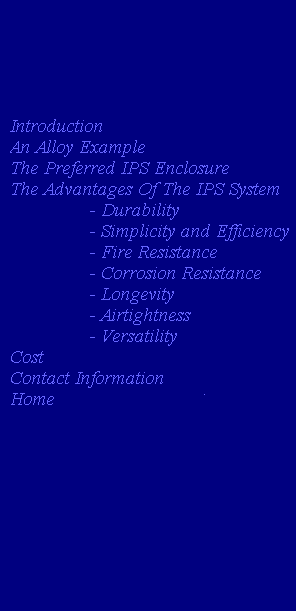
The Advantages Of The IPS System
- Durability:
- Too many buildings have been designed that place efficiency over durability, when the reverse should be taking place. The IPS system, then, is capable of building the most durable buildings available for any function, in any size, and in almost any shape, because IPS panels can be cast and heat-treated of the most durable high-strength alloys and steels, which would undoubtedly remain completely intact through the most severe destructive forces of hurricanes, tornadoes, and extreme seismic activity. For instance, as mentioned, there is one steel that IPS panels could be cast of which is referred to as MAR 350, which is noted for its high toughness and is also the strongest steel in the industry. In fact, this steel has a tensile and compressive strength of 350,000 pounds per square inch, which is 70 times greater than the strength of cast concrete.
- Simplicity and Efficiency:
- Any building that uses the IPS system can be built of nothing more than the panels themselves and the fine lubricant that would be applied to their joints for sliding purposes. In other words, there would be no need for bricks, concrete, steel-reinforcements, or any other construction system. Further yet, there would be no need for nails, screws, nuts, bolts, welds, rivets, glues, sealants, or adhesives of any kind. To add, buildings of any size that would use the IPS system would be perfectly sturdy without posts, columns, beams, frames, trusses, or foundations because of the rigidity of all the membranes of the building, which would constantly support one another as a collective structural totality. However, large flat walls, flat walls that bear heavy loads, large areas of flat roofing, and large expanses of unsupported floor above the base floor would all need to be rigidified by continuous ribs or grids, but in all these cases, these ribs could easily be formed by the IPS system and would firmly interlock with the wall, floor, or roof concerned.
- Fire Resistance:
- Most high-strength steels and alloys will not soften until they have reached a temperature of almost 2,000-degrees F, which is the temperature of a high-temperature fire, so, if a fire could be extinguished within a reasonable period of time after it has started, it is unlikely that the fire would soften the steel or alloy at all, because it would take time for the fire to reach 2,000-degrees F.
- Corrosion Resistance:
- Most steels and alloys that could be incorporated into an IPS panel have excellent resistance to corrosion. The lowest grade of stainless-steel, for instance, would never corrode due to repeated exposure to water, and there are many steels and alloys that have particular resistance to a variety of chemicals as well. In addition, because any given IPS building would be built of only one steel or alloy, there would be no corrosion in that building due to electrogalvanic action between dissimilar metals.
- Longevity:
- Because all panels of an IPS building would exhibit extreme corrosion resistance, excellent fire resistance, and extreme toughness, any building employing the IPS system would last for an extremely-long indefinite period of time.
- Airtightness:
- Because the spacing between interlocked IPS panels would not exceed .020”, and because panel joints would always be subjected to tension or compression, at least one inner feature of every joint of the IPS system would come into firm contact with another after panels have been placed and loaded, thereby preventing air and water from moving in or out of the joints, making a structure that is completely airtight and watertight and completely free of problems that involve freezing or thawing.
- Versatility:
- Finally, the IPS system could be used to build domes, inverted domes, cylinders, toroids, curved walls, straight walls, pyramids, conventional rooftop shapes, floors, and structural ribs.